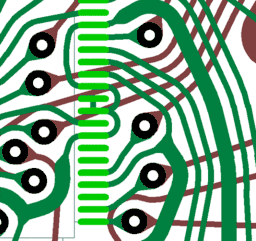Teardrop (electronics)
In printed circuit boards, teardrops are typically drop-shaped features at the junction of vias (teardrop vias) or contact pads (teardrop pads) and traces (teardrop traces).

The main purpose of teardrops is to enhance structural integrity in presence of thermal or mechanical stresses,[1][2][3] for example due to vibration or flexing. Structural integrity may be compromised, e.g., by misalignment during drilling, so that too much copper may be removed by the drill hole in the area where a trace connects to the pad or via.[2][3][4] An extra advantage is the enlarging of manufacturing tolerances, making manufacturing easier and cheaper.[3]
While a typical shape of a teardrop is straight-line tapering, they may be concave.[2] This type of teardrop is also called filleting or straight.[3] To produce a snowman-shaped teardrop, a secondary pad of smaller size is added at the junction overlapping with the primary pad (hence the nickname).[3][5]
Necking
For similar reasons, a technique called trace necking reduces (or necks down[6][7][8]) the width of a trace that approaches a narrower pad of a surface-mounted device or a through-hole with a diameter that is less than the width of the trace, or when the trace passes through bottlenecks (for example, between the pads of a component).[7][8][9][10]
References
- Wahby, Mahmoud (2014-02-21). "Component placement tips and strategies". EDN Network. Archived from the original on 2017-09-24. Retrieved 2017-09-24.
- Loughhead, Phil (2017-05-30). "Removing Unused Pads and Adding Teardrops". Altium Designer technical documentation. Altium. Archived from the original on 2017-09-24. Retrieved 2017-09-24.
- Kolath, Amos (2010). "Why Where When and how teardrops should be added to PCB?". KaiZen Technologies. Archived from the original on 2017-09-24. Retrieved 2017-09-24.
- Lobner, Wilhelm (October 2002). "Empfehlung zu Tear-drops" [Recommendations for tear-drops] (PDF) (in German). AT&S AG, Fachverband Elektronik-Design e.V. (FEV). Archived (PDF) from the original on 2017-09-24. Retrieved 2017-09-24.
- Gutierrez, Keith G.; Coates, Keven (June 2010). "PCB Design Guidelines for 0.5mm Package-on-Package Applications Processor, Part I" (PDF). Texas Instruments. Application Report SPRABB3. Archived (PDF) from the original on 2017-09-24. Retrieved 2015-07-27.
- Loughhead, Phil (2017-04-25). "Interactive Routing". Altium Designer technical documentation. Altium. Archived from the original on 2017-09-24. Retrieved 2017-09-24.
- Byers, T. J. (1991-08-01). Printed Circuit Board Design with Microcomputers (1 ed.). New York, USA: Intertext Publications/Multiscience Press, Inc., McGraw-Hill Book Company. p. 102. ISBN 0-07-009558-2. LCCN 91-72187.
- Kollipara, Ravindranath; Tripathi, Vijai K.; Sergent, Jerry E.; Blackwell, Glenn R.; White, Donald; Staszak, Zbigniew J. (2005). "11.1.3 Packaging Electronic Systems - Design of Printed Wiring Boards" (PDF). In Whitaker, Jerry C.; Dorf, Richard C. (eds.). The Electronics Handbook (2 ed.). CRC Press, Taylor & Francis Group, LLC. p. 1266. ISBN 978-0-8493-1889-4. LCCN 2004057106. Archived (PDF) from the original on 2017-09-25. Retrieved 2017-09-25.
- US3560256A, Abrams, Halle, "Packaging Electronic Systems", published 1971-02-02, assigned to Western Electric Co.
- Thierauf, Stephen C. (2004). High-Speed Circuit Board Signal Integrity (PDF) (1 ed.). Norwood, MA, USA: Artech House, Inc. pp. 104–105. ISBN 1-58053-131-8. Archived (PDF) from the original on 2017-09-26. Retrieved 2017-09-26.